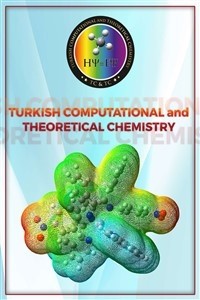MULTIVARIANT QSAR MODEL FOR SOME POTENT COMPOUNDS AS POTENTIAL ANTI-TUMOR INHIBITORS: A COMPUTATIONAL APPROACH
MULTIVARIANT QSAR MODEL FOR SOME POTENT COMPOUNDS AS POTENTIAL ANTI-TUMOR INHIBITORS: A COMPUTATIONAL APPROACH
ABSTRACT A computational approach was employed to develop multivariate QSAR model to correlate the chemical structures of the ciprofloxacin analogues with their observed activities using a theoretical approach. Genetic Function Algorithm (GFA) and Multiple Linear Regression Analysis (MLRA) were used to select the descriptors and to generate the correlation QSAR models that relate the activity values against tumor with the molecular structures of the active molecules. The models were validated and the best model selected has squared correlation coefficient (R2) of 0.990531, adjusted squared correlation coefficient (Radj) of 0.95962 and Leave one out (LOO) cross validation coefficient () value of 0.942963. The external validation set used for confirming the predictive power of the model has its R2pred of 0.8486. Stability and robustness of the model obtained by the validation test indicate that the model can be used to design and synthesis other ciprofloxacin derivatives with improved anti-tumor activity.
___
- REFERENCES[1] N.B. Delongchamps, A. Singh, G.P. Haas, Epidemiology of prostate cancer in Africa: another step in the understanding of the disease?, Current Problems in Cancer. 31 (2007) 226–236.[2] F.T. Odedina, J.O. Ogunbiyi, F.A. Ukoli, Roots of prostate cancer in African-American men., Journal of the National Medical Association. 98 (2006) 539.[3] A. Rathod, Antifungal and Antibacterial activities of Imidazolylpyrimidines derivatives and their QSAR Studies under Conventional and Microwave-assisted, Int J PharmTech Res. 3 (2011) 1942–1951.[4] J. Azéma, B. Guidetti, J. Dewelle, B. Le Calve, T. Mijatovic, A. Korolyov, J. Vaysse, M. Malet-Martino, R. Martino, R. Kiss, 7-((4-Substituted) piperazin-1-yl) derivatives of ciprofloxacin: synthesis and in vitro biological evaluation as potential antitumor agents, Bioorganic & Medicinal Chemistry. 17 (2009) 5396–5407.[5] Z. Li, H. Wan, Y. Shi, P. Ouyang, Personal experience with four kinds of chemical structure drawing software: review on ChemDraw, ChemWindow, ISIS/Draw, and ChemSketch, Journal of Chemical Information and Computer Sciences. 44 (2004) 1886–1890.[6] S.E. Adeniji, S. Uba, A. Uzairu, in silico study for investigating and predicting the activities of 1, 2, 4-triazole derivaties as potent anti-tubercular agents, the journal of engineering and exact sciences. 4 (2018) 0246–0254.[7] P. Singh, Quantitative Structure-Activity Relationship Study of Substituted-[1, 2, 4] Oxadiazoles as S1P1 Agonists, Journal of Current Chemical and Pharmaceutical Sciences. 3 (2013).[8] G. Melagraki, A. Afantitis, K. Makridima, H. Sarimveis, O. Igglessi-Markopoulou, Prediction of toxicity using a novel RBF neural network training methodology, Journal of Molecular Modeling. 12 (2006) 297–305.[9] A. Afantitis, G. Melagraki, H. Sarimveis, P.A. Koutentis, J. Markopoulos, O. Igglessi-Markopoulou, A novel QSAR model for predicting induction of apoptosis by 4-aryl-4H-chromenes, Bioorganic & Medicinal Chemistry. 14 (2006) 6686–6694.[10] A.K. Chakraborti, B. Gopalakrishnan, M.E. Sobhia, A. Malde, 3D-QSAR studies of indole derivatives as phosphodiesterase IV inhibitors, European Journal of Medicinal Chemistry. 38 (2003) 975–982.[11] W. Wu, B. Walczak, D.L. Massart, S. Heuerding, F. Erni, I.R. Last, K.A. Prebble, Artificial neural networks in classification of NIR spectral data: design of the training set, Chemometrics and Intelligent Laboratory Systems. 33 (1996) 35–46.[12] K.F. Khaled, Modeling corrosion inhibition of iron in acid medium by genetic function approximation method: A QSAR model, Corrosion Science. 53 (2011) 3457–3465.[13] A. Tropsha, P. Gramatica, V.K. Gombar, The importance of being earnest: validation is the absolute essential for successful application and interpretation of QSPR models, Molecular Informatics. 22 (2003) 69–77.[14] R. Veerasamy, H. Rajak, A. Jain, S. Sivadasan, C.P. Varghese, R.K. Agrawal, Validation of QSAR models-strategies and importance, International Journal of Drug Design & Discovery. 3 (2011) 511–519.[15] S.E. Adeniji, S. Uba, A. Uzairu, QSAR Modeling and Molecular Docking Analysis of Some Active Compounds against Mycobacterium tuberculosis Receptor (Mtb CYP121), Journal of Pathogens. 2018 (2018).[16] M. Jalali-Heravi, A. Kyani, Use of computer-assisted methods for the modeling of the retention time of a variety of volatile organic compounds: a PCA-MLR-ANN approach, Journal of Chemical Information and Computer Sciences. 44 (2004) 1328–1335.
- ISSN: 2587-1722
- Başlangıç: 2017
- Yayıncı: Koray SAYIN
